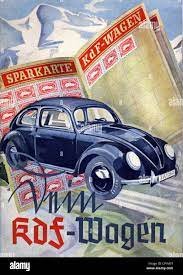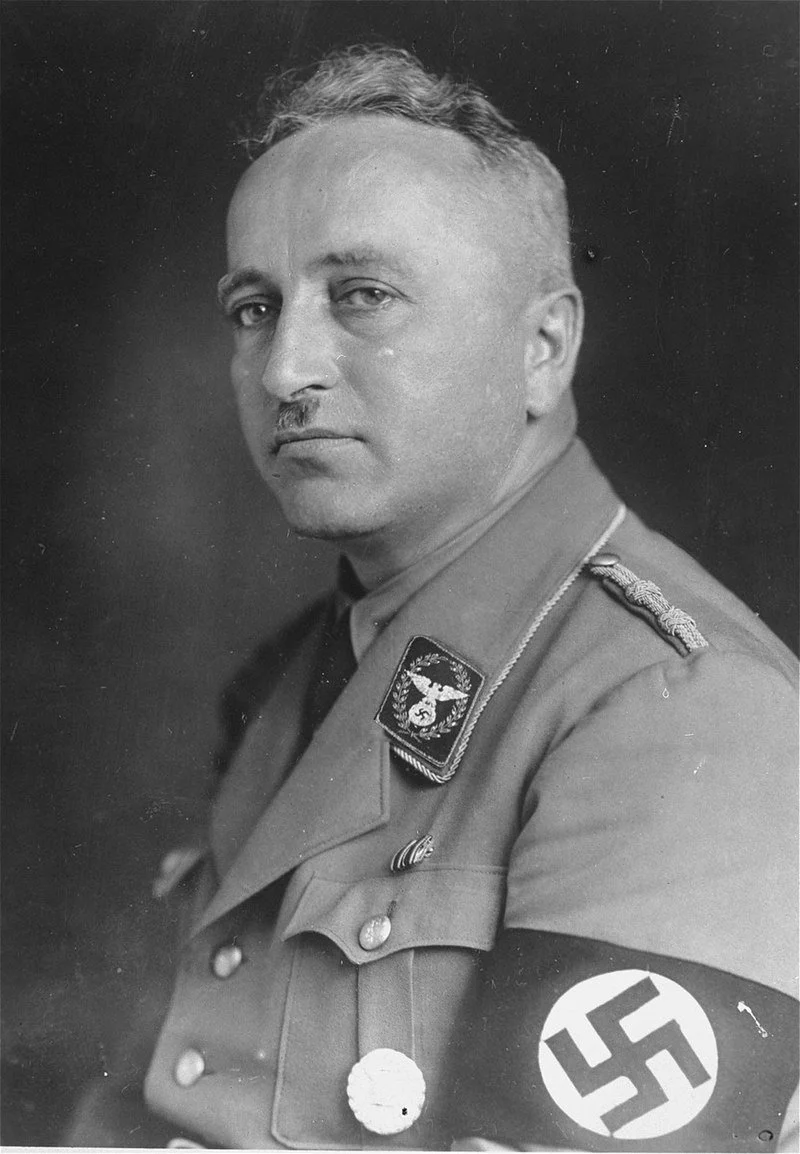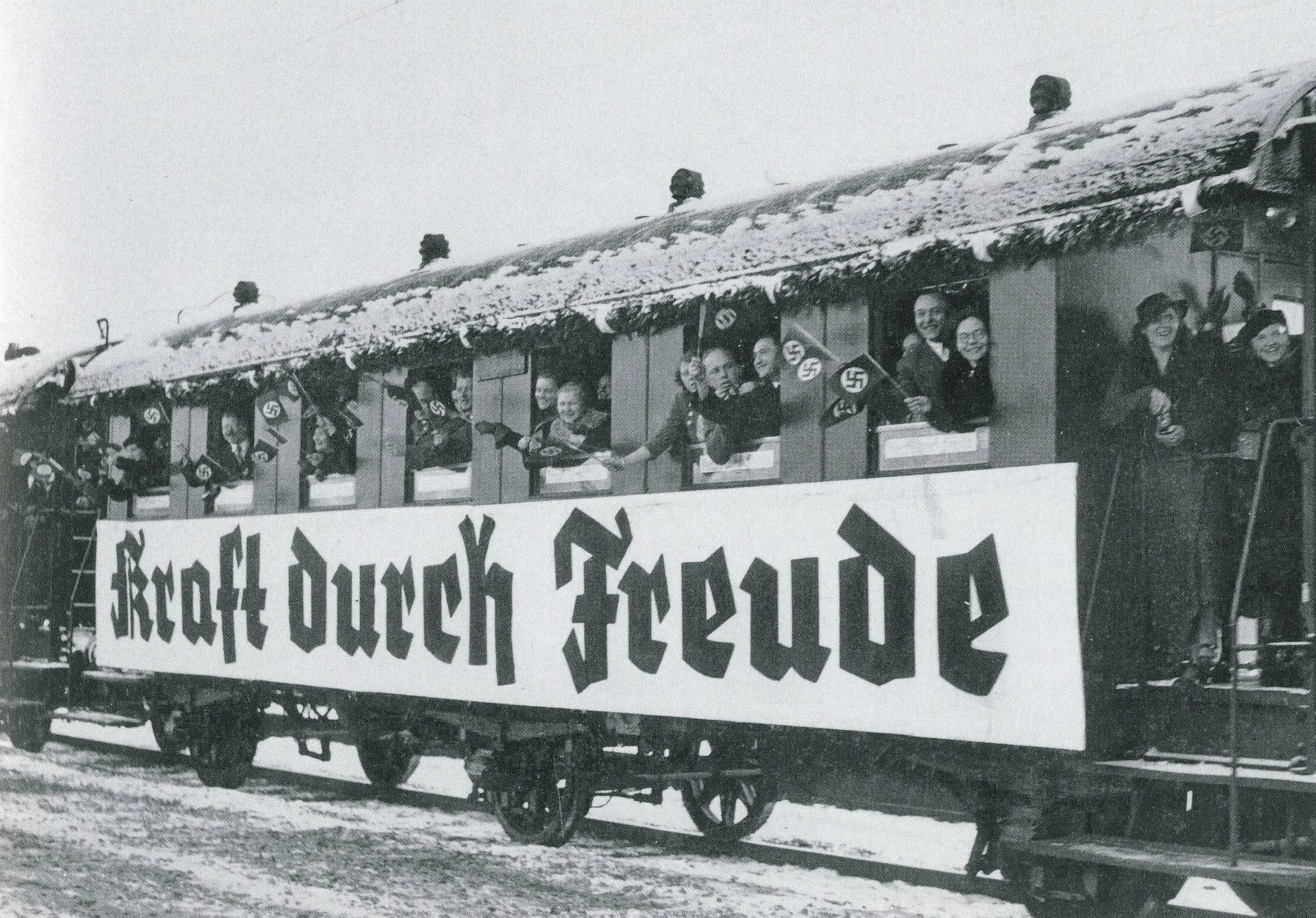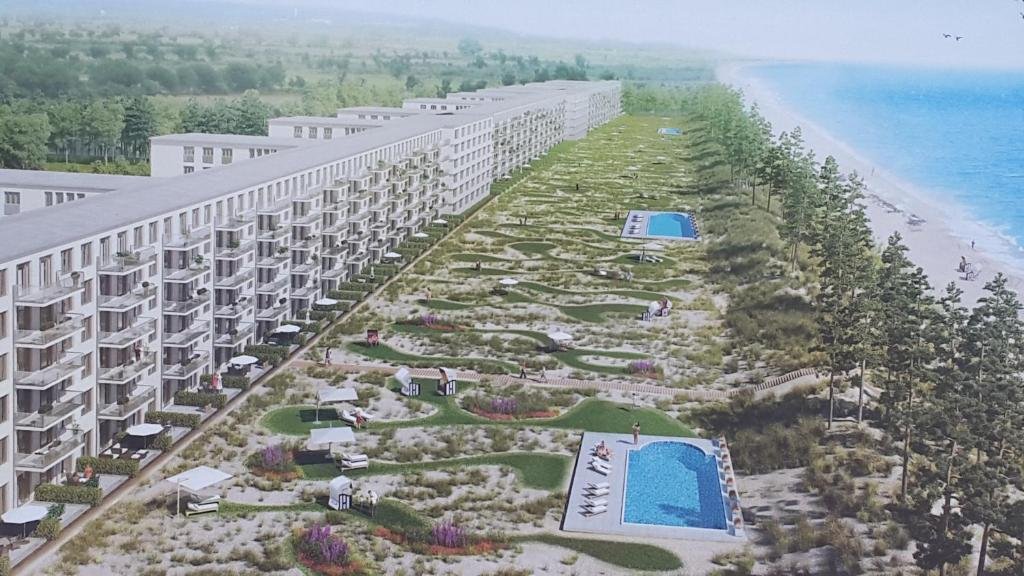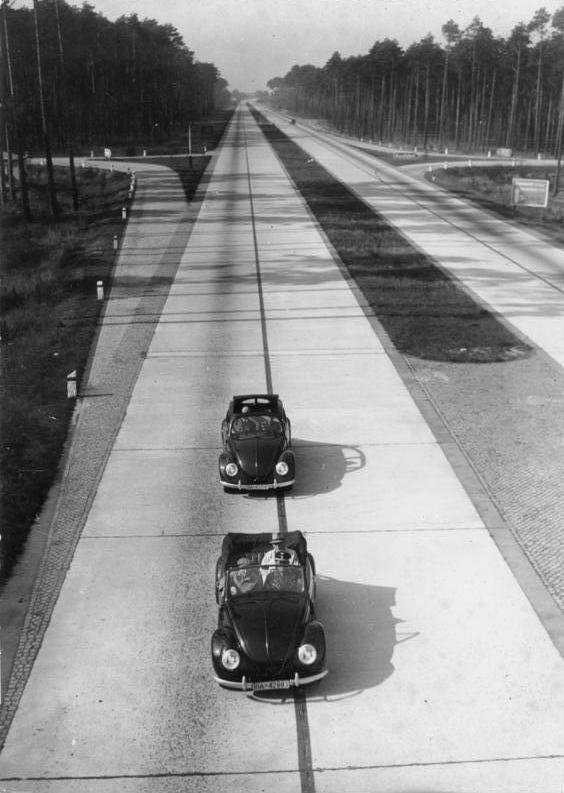
“Kraft durch Freude”
Strength through Joy!
KDF was part of the German Labour Front (German: Deutsche Arbeitsfront - ), the national labour organization at that time. Set up in November 1933 as a tool to promote the advantages of Nazism to the German people and internationally, while also being utilized to ease the process of the rearmament of Germany. It was also intended to compensate for the poor increases in wages and for the loss of trade union rights. Through its structure of organized events and promotion of propaganda, it was also intended to prevent dissident and anti-state behavior. By 1939, it had become the world's largest tourism operator.
KdF had a number of individual departments.
The Beauty of Labour Department
The Beauty of Labour (Schönheit der Arbeit) department was devoted to improvements in the workplace, from general hygiene to reduction of sound pollution.
Sports Office
The Sports Office organized tennis, skiing, and likewise sports that the working class were previously unable to partake in. Its main concerns were in building 'everyday joy' and improving the health of the masses, and KdF took a keen interest in building the physicality and bodily strength of the German population. Physical education classes and gymnastic events were scheduled on weekends and after working hours, but also included skiing and hiking trips. It also encouraged workers to partake in physical exercise and sports, encouraging employers to provide access to facilities and equipment during work hours and after hours.
Adult Education Office
The Adult Education Office was headed by Fritz Leutloff. Its goal was to educate Germans on cultural and artistic topics.
Leisure time office
The Leisure Time Office enabled workers to attend theatres and concerts by organizing local events and offering discounted tickets. It also organized concerts and events to take place in factories. As the Adult Education Office focused more on propaganda and refined education, the Leisure Time Office was more concerned with the recreational aspects of spare time.
Travel Office
The largest and most profitable department was the Office for Travel, Hiking, and Holidays, headed by Bodo Lafferentz. Organizing both domestic and international excursions, for the first time workers were able to travel at length. This was achieved by offering discounts on travel and tour packages, sending thousands of Germans on holidays before 1939.
Office of Folklore
The Office for Folklore and Homeland was tasked with organizing smaller Nazi organizations that promoted the 'folklore' and the idea of Lebensraum, but was dissolved in 1934.
KdF was composed of several departments with their own specific goals, with each department organizing different leisure activities. It organized activities such as sporting events on factory floors, art exhibitions, discounted concerts and, most famously and popularly, subsidized holidays and cruise trips. One of its largest departments, although sometimes considered a separate organization altogether, was Beauty of Labour, which concerned itself with physical and sanitary improvements of the workplace. KdF was responsible for the improvement of several factories and sports facilities throughout its operations in the 1930s.
KdF was supposed to bridge the class divide by making middle-class leisure activities available to the masses. It also sought to bolster the German tourist industry, something it did successfully up until the outbreak of World War II. Official statistics showed that in 1934, 2.3 million people took KdF holidays. By 1938, this figure rose to 10.3 million. With the outbreak of war in 1939, most of the organization's programs were suspended and several projects, such as the Prora holiday resort, were never completed.
The Leisure Time Office and Adult Education Office, seeking to educate adults in arts and culture as well as to ensure they spend their time profitably, took steps to provide access to events for workers. To do as such, exhibitions, concerts and cultural events were held within factories to ensure workers had the ability to attend. Exhibitions of art created by exclusively German artists, plays and musicals, and concerts were organized and admission for workers was either very cheap or free. Some art exhibitions featured art created by workers, oftentimes created in classes organized by the KdF. At all exhibitions, the art was for sale. In some cases, renowned composers such as Wilhelm Brueckner-Rueggeberg and Wilhelm Furtwängler led the Berlin Philharmonic orchestra in these performances, while at other times concerts would be conducted by local composers and played by local orchestras.
Following its inception, KdF began to provide a wide range of activities at an affordable price, ranging from concerts and theatre trips to weekend trips and holidays. Workers could enter KdF competitions and win prizes that would send them and their families to local events, or on extended trips either in Germany or abroad. Many of their events occurring after the work day and on weekends, the government sought not only to create a positive and productive environment, but also to dissuade potential anti-state activities.
Robert Ley, head of KDF and German Volk getting ready to enjoy an after work theatre showBorrowing from the Italian fascist organization Dopolavoro ('After Work'), but extending its influence into the workplace as well through the Beauty of Labour department, the KdF rapidly developed a wide range of activities and quickly grew into one of Nazi Germany's largest organizations. Wardens were posted in every factory and workshop employing more than 20 people. It strove to improve the hygiene of workplaces, by providing toilets, locker rooms, and proper washing facilities. It also looked to improve air quality and reduce noise for workers. The government offered tax incentives as encouragement, and by 1938 the conditions of 34,000 workplaces had improved considerably. This was largely achieved by workers completing renovations while on unpaid overtime.
KdF stressed that partaking in sports would encourage physical health and a healthy attitude, and as such the Sports Office began to organize physical education events for workers. Under supervision of the National Socialist League of the Reich for Physical Exercise, by 1936 sports and physical training were implemented in factories, and employees under the age of 18 were required to spend time in their workweek performing exercise. The Sports Office also pushed employers to build recreation facilities on work grounds, such as tennis courts, and offered tax incentives as encouragement. Official estimates by the German Labour Front show that by 1939, approximately 3,000 sports facilities were created and over 12 million sports courses were organized through these efforts. Overall, it sought heightened physical and mental health for workers, important aspects for potential citizens living in the 'people's community.'
The Office for Travel, Hiking, and Holidays offered various discounted vacation trips, ranging in length from day and weekend trips to one week or upwards of three weeks. Taking travelers via rail and bus to their destinations, within Germany or its occupied and annexed territories, the office organized activities such as hiking trips and swimming excursions. In most destinations hotelkeepers and some local businesses saw increased profits thanks to the increasing number of tourists, as did the Deutsche Reichsbahn (German National Railway). Popular extended holiday destinations included the Alps, the Black Forest, and the coasts of the North Sea and Baltic Sea, but most of the trips booked were overnight or over a weekend.
Most famously, the office also offered discounted cruise trips to German citizens. Although not initially planned to be a program offered by KdF, the initial successes of the cruises led to six large ships, including the MV Wilhelm Gustloff (I have a page looking at this ships history and fate) and the MV Goya, being built specifically for use by KdF while a further six were chartered. They were first ships to be built specifically for cruises. They were collectively known as the KdF fleet, with the MV Robert Ley being considered as its flagship. Through these cruises Nazism was promoted internationally, and KdF travelers therefore were expected to represent its positively by dressing modestly and behaving appropriately. Ship events included masquerades, political and educational lectures, and events dedicated to displaying customs of individual German regions, such as shows of dance groups performing dances from their home regions. Drinking alcohol was prohibited, and the government planted spies on ships instructed to pose as passengers and monitor participants' behavior. Cruise trips were sometimes offered as prizes in KdF competitions, but were largely affordable; an eighteen-day trip to Madeira cost 120 Reichsmarks, the equivalent to about four weeks' average salary at the time, and a seven-day trip to Norway cost about 50 Reichsmarks. Although cruises were inexpensive, workers were often greatly underrepresented on these voyages, with most of KdF's cruise participants being from the middle class. Following Germany's invasion of the Soviet Union, tourism opportunities were suspended and the organization shifted to more domestic activities and troop entertainment; up until this point, KdF had sold more than 45 million package tours and excursions, totaling over 700,000 German travelers
MV Wilhelm Gustloff, KdF Rail trips and Ley with Hitler on the Robert Ley Cruise ship.
Hilter’s Holiday Camp
Robert Ley, head of the German Labour Front – of which Strength Through Joy was a subsidiary – envisioned Prora as a parallel to Butlins, which were British "holiday camps" designed to provide affordable holidays for the average worker. Prora was designed to house 20,000 holidaymakers, under the ideal that every worker deserved a holiday at the beach. Designed by Clemens Klotz, who won a design competition overseen by Adolf Hitler's chief architect Albert Speer, all rooms were planned to overlook the sea, while corridors and sanitation are located on the landward side. Each room of 5 metres (16 ft) by 2.5 metres (8.2 ft) was to have two beds, a wardrobe and a sink. There were communal toilets, showers and bathrooms on each floor.
Hitler's plans for Prora were much more ambitious. He wanted a gigantic sea resort, the "most mighty and large one to ever have existed", holding 20,000 beds. In the middle, a huge building was to be erected. At the same time, Hitler wanted it to be convertible into a military hospital in case of war. Hitler insisted that the plans of a giant indoor arena by architect Erich zu Putlitz be included. Putlitz's Festival Hall was intended to be able to accommodate all 20,000 guests at the same time. His plans included two wave-swimming pools, a cinema and a theatre. A large dock for passenger ships was also planned.
The designs won a Grand Prix award at the 1937 Paris World Exposition
Nazi Advert for Prora and Prora today
Check out the Prora page - click me!
Check out the Prora page - click me!
The Volks Wagon - The Peoples Car
KdF's most ambitious programme for German workers was to set up production of an affordable car, the KdF-Wagen, which later became the Volkswagen Beetle (Volkswagen being German for 'People's Car'). This was originally a project undertaken at Hitler's request by the engineer Ferdinand Porsche. When the German car industry was unable to meet Hitler's demand that the Volkswagen be sold at 1,000 Reichsmarks or less, the project was taken over by the German Labour Front (Deutsche Arbeitsfront; DAF). Now working for the DAF, Porsche built a new Volkswagen factory in Fallersleben at a huge cost, partly met by raiding the DAF's accumulated assets and misappropriating[citation needed] the dues paid by DAF members.
The Volkswagen was sold to German workers on an instalment plan, where buyers of the car made payments and posted stamps in a stamp-savings book, which, when full, would be redeemed for the car. Due to the shift of wartime production, no private citizen ever received a KdF-Wagen, although after the war, Volkswagen did give some customers a 200 DM discount for their stamp-books. The Beetle factory was then primarily converted to produce the Kübelwagen, the German equivalent of the Jeep. The few Beetles that were produced went to the diplomatic corps and military officials



